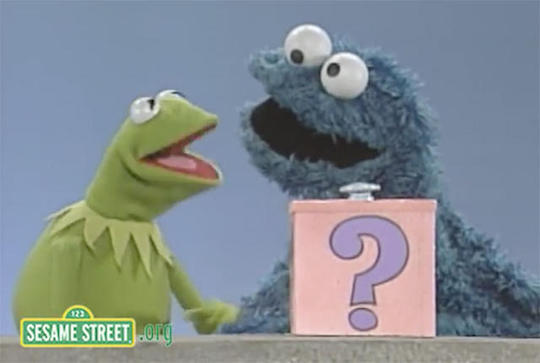Friend of the blog and devoted father Peter Franke drew my attention to this Sesame Street sketch, in which Kermit has a mystery box. If anyone can guess what’s in the box, they can have it. “Is it cookie?” Cookie Monster asks, appearing from beneath the frame.1 “Bye-bye,” he says upon learning it is not. In addition to adding tension by giving Kermit something to want from him—i.e. cooperation in the Mystery Box game—Cookie Monster’s rapid entrance-exit cleanly establishes the premise of the sketch. He wants cookies. That’s all he wants, and he wants them very much. The first half of this sketch demonstrates the theory that comedy happens when a character acts like himself to the point of absurdity. Behold:
Close analysis of puppet show for children after the jump.
The first 20 seconds of this sketch are remarkably efficient. Kermit explains the Mystery Box, which is the ostensible premise that Cookie Monster starts to break as soon as he arrives. The real premise is the tension between Kermit’s attempts to get him to play along and C. Monster’s maniacal fixation on cookies. These two forces come into conflict when Kermit convinces him to stay by telling him that if he guesses what’s in the box, he will get a cookie.
Immediately, (:37) Cookie Monster starts throwing out arbitrary guesses. It’s a horse! It’s a pogo stick! It’s a cotton ball! It’s a rump roast! This rapid succession gives us to understand that he sees the game only as a means to an end, i.e. cookie acquisition, which is of course not what Kermit wants. He wants a willing participant in the Mystery Box bit.
And so the sketch settles into a recognizable straight-man/comic dynamic. Kermit is the straight man. He gives the audience information and sets up Cookie Monster’s punchlines, but he also does something more important. He has an expectation about how the Mystery Box sketch should go—an expectation Cookie Monster gleefully frustrates with his namesake obsession.
The next minute or so of jokes—which I find delightful—center on him doing whatever he can think of to get a cookie. Because he is a lovable idiot, his cookie-mania manifests not in strategies to acquire a cookie so much as opportunities to believe there’s a cookie in the box. It’s something you eat? It’s a cookie. It’s round? It’s a cookie. It’s a thing you eat that is round and orange? Okay, maybe a cookie. Cookie Monster’s behavior is absurd, but it’s also governed by an ironclad rationale. We know exactly what he’s up to, and in the split second it takes us to figure out how his nonsense behavior serves that purpose, we laugh.
Of course, it’s possible that’s not the funny part. If you subscribe to the Cleese Principle—that comedy is not watching someone do something funny, but rather watching someone else watch someone do something funny—then Kermit is the funny part. The real laughs come from watching him lose his temper. He is exasperated that Cookie Monster can’t guess there’s an orange in the box, even when he has been given the clues “food,” “round,” and “orange.” He yells and flails his puppet arms, which is hilarious. Ironically, Cookie Monster’s absurd focus on cookies forces Kermit to become absurdly focused on playing out the Mystery Box game, even after it has clearly fallen apart.
This is how the character-acts-very-much-like-himself premise avoids monotony. The problem with structuring a series of jokes around Cookie Monster wanting a cookie is that it threatens to become one-note. You can escalate the absurdity of his cookie fixation for a while, but it gets harder and harder to keep things moving. The solution, here, is to locate the progress of the sketch in Kermit’s mounting frustration, rather than in CM’s mounting absurdity. You don’t need to wrack your brains coming up with even crazier ways for him to pursue cookies. You can just let Kermit explode, because everybody likes to watch the straight man go nuts.
That’s your A to B, right there. The third part of this sketch, the C, is kind of formless in keeping with the modern style. It’s basically a long joke based on tone, as Cookie Monster delivers an impassioned appeal to Kermit’s friendship in order to get—wait for it—a cookie. This gag is the culmination of a trend that has been bubbling beneath the surface of the sketch for the last couple of minutes: Cookie Monster falling out of character to speak lucidly in ad libs, as in 1:10 to 1:27. It’s funny when he does this, but it’s also kind of a third-wall joke, since it relies on reminding the audience that there are real people behind these childishly absurd characters. It’s not as funny as the first half, but it gets us to the ending we know must arrive: Cookie Monster devouring a cookie. Om nom nom, you guys. Fin.





Missed a golden opportunity to use the term “eponymous.” I’m disappointed.